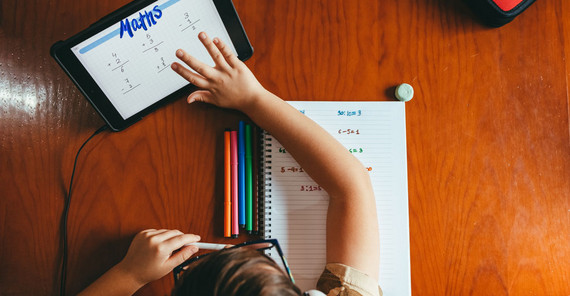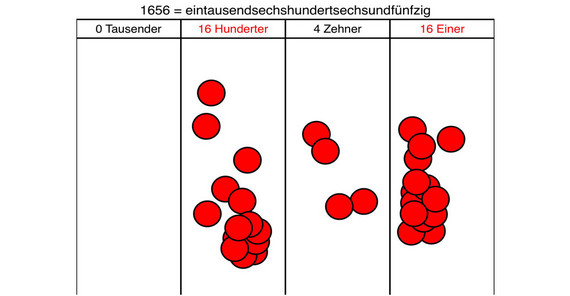The app “Place Value Chart” shows a digital chart: By tapping their fingers, children can place small tokens in individual columns, which, depending on their placement, represent ones, tens, or hundreds etc. In contrast to a normal place value chart on paper, the digital tokens can be moved back and forth between the columns. Kortenkamp explains the importance of this in the following way “if you move a token to the right from a high-order column to a low-order column, it is 'unbundled' and transformed into the corresponding number of tokens that can compensate for the difference in the value of the column. For example, a hundred in the tens column unbundles (breaks down) into ten tens, because 1x100 is 10x10.” A movement of a token to the left, i.e. from low-order to high-order columns, only works if there are enough tokens in this column to represent the higher value. For example, if there are 17 ones in the chart, you can move one token from the ones to the tens, and nine more tokens are automatically taken along and “bundled” to the tens column to form one ten.
The app contributes to the development of a basic understanding of number representation by automating the bundling and unbundling that is extensively practiced in class. As Kortenkamp explains, “it also promotes abstraction from the concrete number to ‘counting tokens’ which are later replaced by numbers”. To measure the learning success, he and his team have developed a test in which children are expected to demonstrate their flexibility in representing numbers in a place value chart. They stamp the results of various addition tasks in place value charts on paper using a “token stamp” and are then asked whether they can represent the same number in a different way e.g. 9 + 5 can be represented by 14 stamps in the ones column or by one stamp in the tens column and four stamps in the ones column. “We link the flexibility shown in the decimal system back to the activities that the children performed in the app”, Kortenkamp says.
Six eggs in a carton
The app underwent such a practical test in the 3rd grade of Ludwig Renn Primary School in Potsdam-Eiche. The mathematics teachers had developed place value lessons, based on the researchers’ ideas, which were then video recorded. “This was very helpful, because only in this way can we be sure that our approaches are adapted to the school context,” Kortenkamp reports. To use the app successfully in class, teachers need to know all the components of flexible place value understanding and must practice the bundling with the children with real material. “Bundling means combining similar objects into groups of the same number of elements, for example always six eggs to an egg carton. You can then build on this,” explains the professor who has developed guidelines for teachers on how to use the place value chart.
Since mathematics knows no language barriers, the app can also be used internationally. Thanks to a cooperation with Prof. Kevin Larkin from Griffith University, it was also tested in Australia last year. “Although we found many similarities between the abilities of children in the two countries, there were also some differences in the introduction of place values in primary school, which naturally influenced the use of apps. For example, the actual teaching sequences that were carried out with the app were similar; however, in Australia, certain progressions were followed very strictly, while the teaching in Germany gives teachers more freedom, but also places more responsibility on them,” Kortenkamp observed. Australian school children are monitored much more closely. Not only the teacher but also the school management and the other teaching staff are informed about the learning progress. A lot of testing is completed and the results stored in databases. “This is a completely different teaching culture than ours – and in some places it is certainly helpful, even though I appreciate the freedom our teachers have, provided they are aware of their responsibility and are very well trained, both professionally and pedagogically”, Kortenkamp concludes.
Covid-19 thwarted project in Australia
It is still too early to draw concrete conclusions from the German-Australian comparison of teaching. The Covid-19 pandemic prevented additional mutual visits at schools. Thanks to an extension of the project, however, the researchers will be able to conduct more refined tests and specific observations in a second round, hopefully to be completed in 2021. The results of the first research phase show that the use of the app can help build a flexible understanding of place value if children dare to deviate from the standard representation. “Since we saw strong differences between countries, and also between different outcomes in the eight school classes, we now have to either stipulate the actual teaching in more detail or observe more closely how the teachers differ,” Kortenkamp says.
As with all of Kortenkamp’s other research projects, the results of this study will be integrated into the training of future teachers. However, the educational researcher knows that innovations in teaching, which are only taught at university, need approximately 40 years to become widely accepted and reach a majority of teachers. He is therefore convinced that educational developments initiated by the university can only succeed when they occur concurrently with broadly based programs in continuing education. “To some extent, we transport innovations through the qualification of multipliers, i.e. those who conduct further training,” says Kortenkamp, who is particularly involved in the German Center for Mathematics Teacher Education. Another idea for moving from research into the actual practice of teaching is the participatory approach of “Digital Labs”, which researchers want to establish in the “Innovative University” project. Kortenkamp sees great opportunities in study programs for out-of-field-teachers and lateral entrants. “If we qualify teachers of other subjects as mathematics teachers alongside their work, they will directly put our research into practice.” Here, the Covid-19 crisis is proving to be a catalyst. “Preparing our courses in a blended learning format allows us to offer excellent and didactically well-conceptualized courses with little additional effort, which will also work in a large state like Brandenburg.”
The Researcher
Prof. Ulrich Kortenkamp studied mathematics and computer science in Münster. After academic stays in Berlin, Zurich, Karlsruhe, and Halle, he became Professor of Didactics of Mathematics at the University of Potsdam.
Mail: ulrich.kortenkampuuni-potsdampde
https://kortenkamps.net
The Project
Supporting Young Children’s Numeracy and enhancing the Mathematics Pedagogical Content Knowledge of teachers via the use of a custom designed mathematics app
Duration: 1/2019–12/2021
Participating: University of Potsdam, Griffith University
Funded: German Academic Exchange Service (DAAD) and Australian Universities
This text was published in the university magazine Portal Wissen - Two 2020 „Health“.


